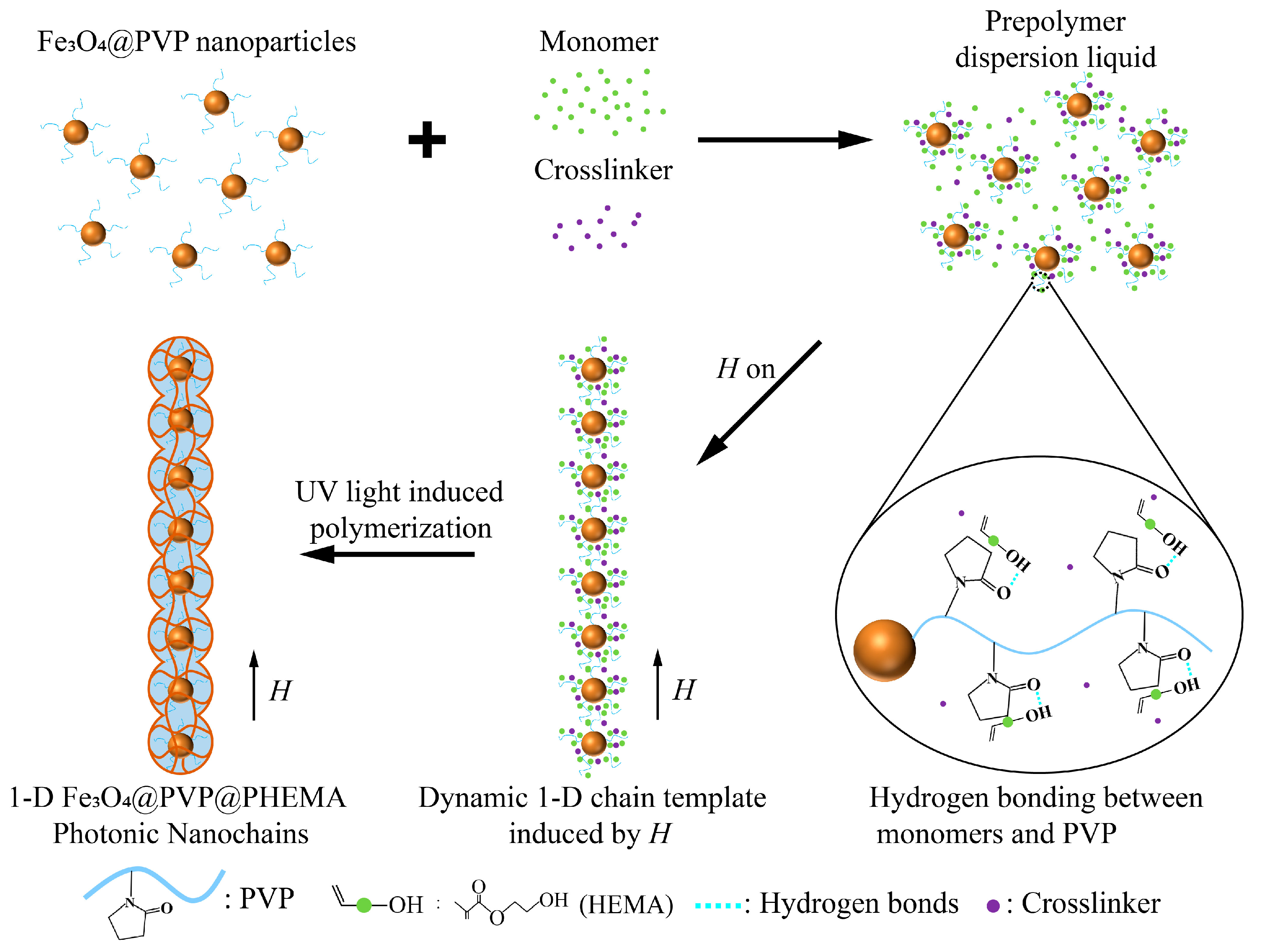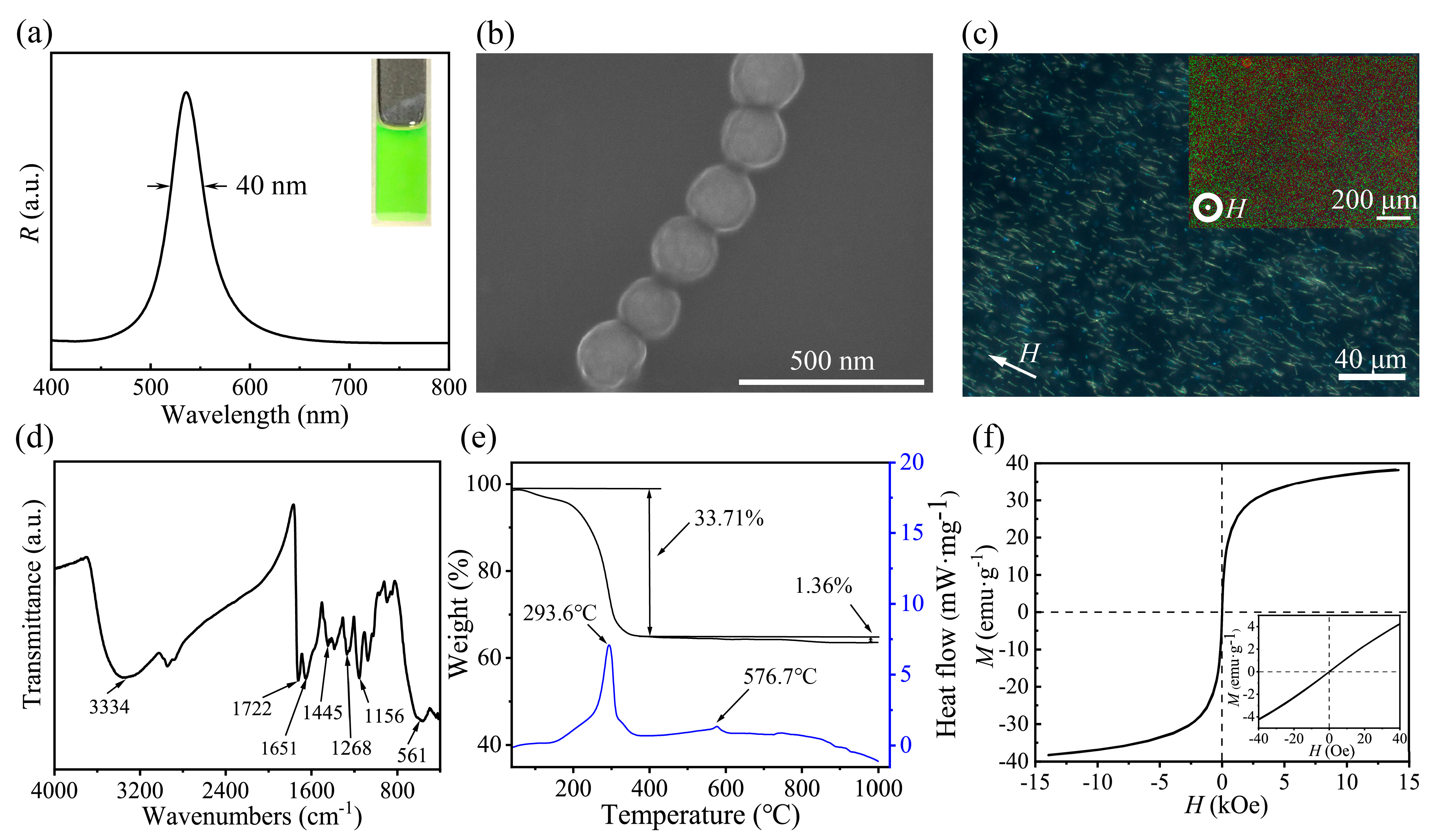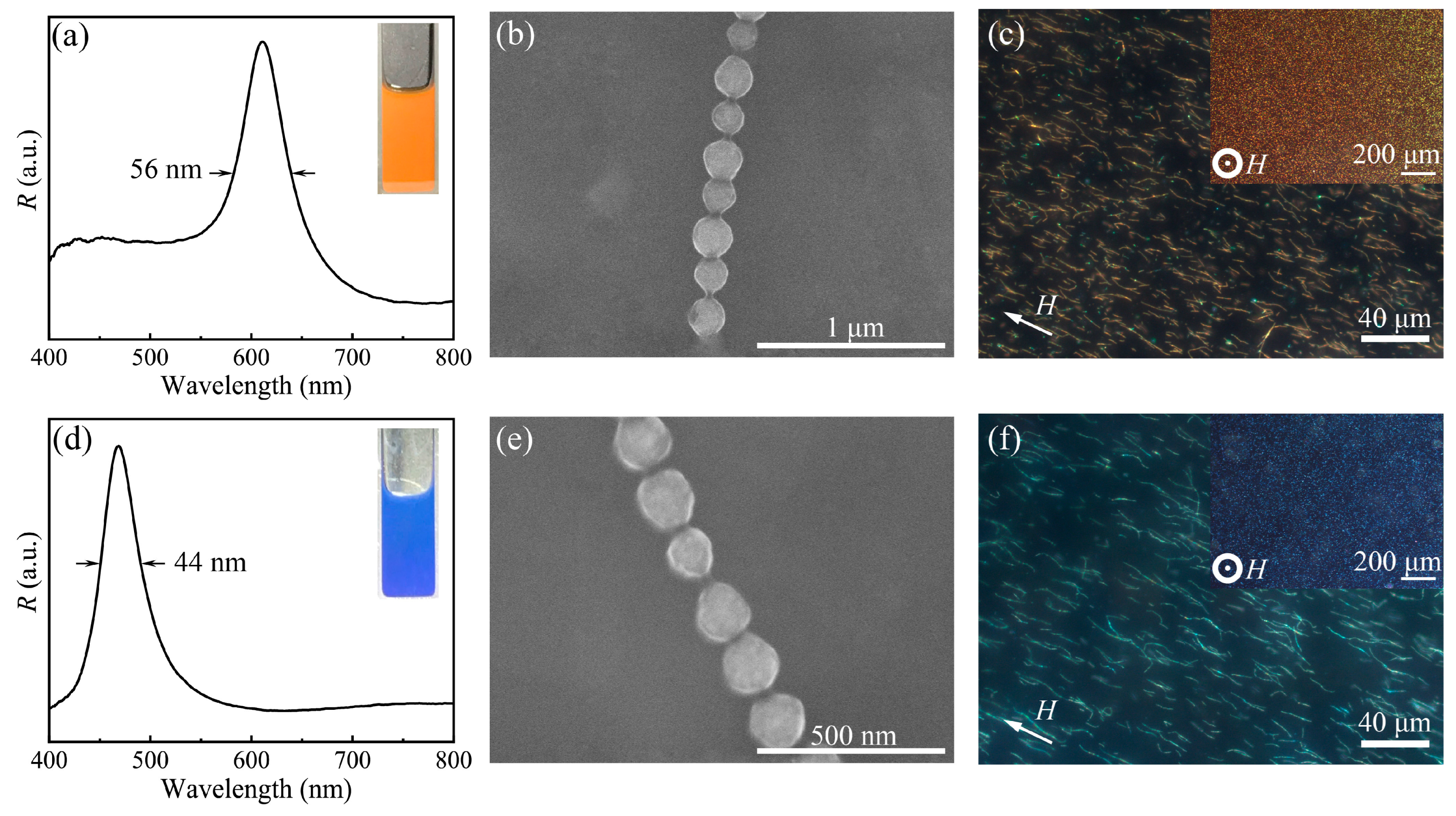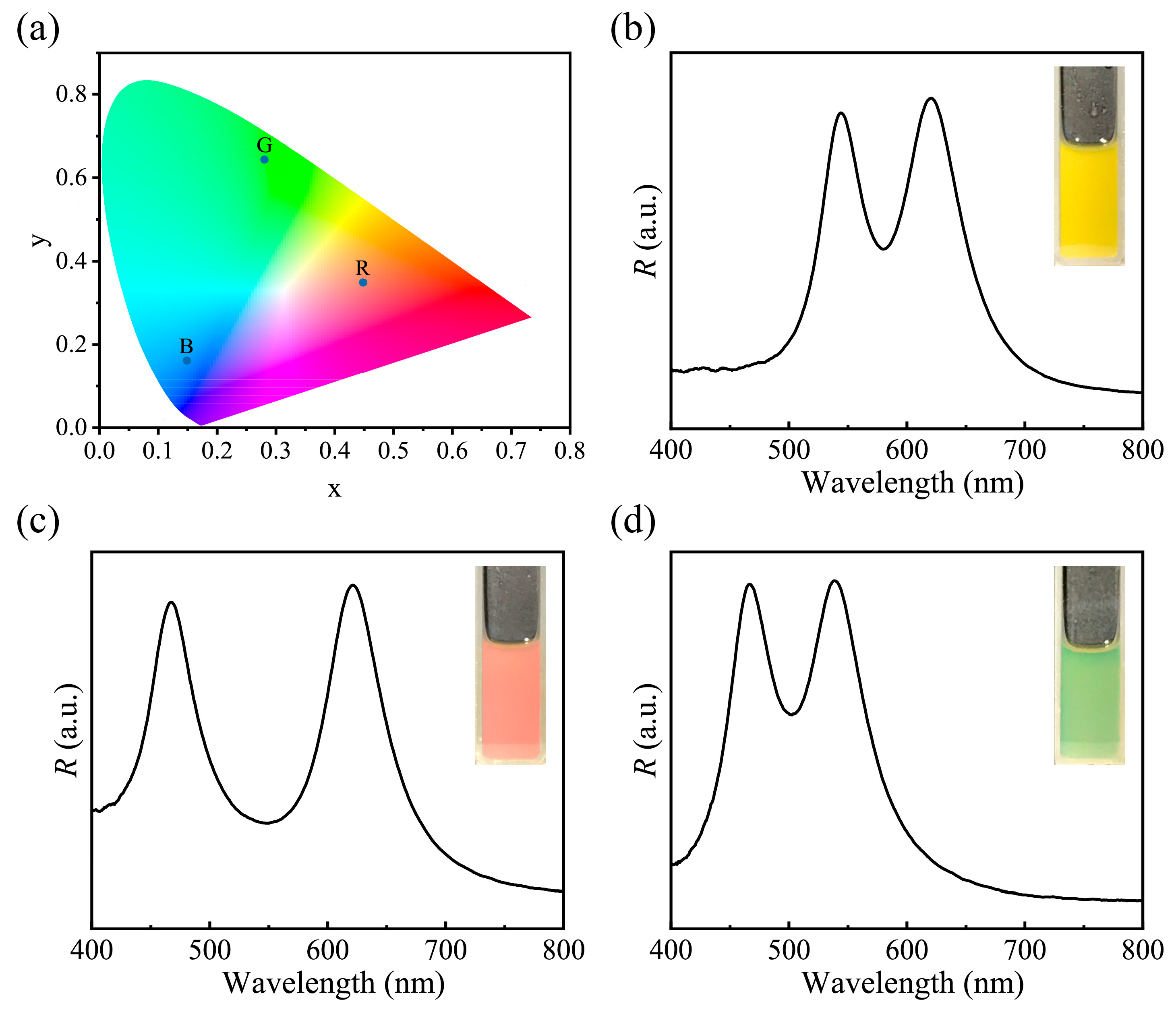Versatile Double Bandgap Photonic Crystals of High Color Saturation
Abstract
:1. Introduction
2. Materials and Methods
2.1. Materials
2.2. Preparation of Fe3O4@PVP@PHEMA Photonic Nanochains
2.3. Preparation of Double Bandgap Photonic Crystal Film
2.4. Characterizations
3. Results
4. Conclusions
Supplementary Materials
Author Contributions
Funding
Institutional Review Board Statement
Informed Consent Statement
Data Availability Statement
Acknowledgments
Conflicts of Interest
References
- Shiono, M.; Matsugaki, N.; Takeda, K. Structure of the blue cornflower pigment. Nature 2005, 436, 791. [Google Scholar] [CrossRef]
- Gsänger, M.; Bialas, D.; Huang, L.; Stolte, M.; Würthner, F. Organic Semiconductors based on Dyes and Color Pigments. Adv. Mater. 2016, 28, 3615–3645. [Google Scholar] [CrossRef] [PubMed]
- Kaur, M.; Choi, D.H. Diketopyrrolopyrrole: Brilliant red pigment dye-based fluorescent probes and their applications. Chem. Soc. Rev. 2015, 44, 58–77. [Google Scholar] [CrossRef]
- Mäthger, L.M.; Senft, S.L.; Gao, M.; Karaveli, S.; Bell, G.R.R.; Zia, R.; Kuzirian, A.M.; Dennis, P.B.; Crookes-Goodson, W.J.; Naik, R.R.; et al. Bright White Scattering from Protein Spheres in Color Changing, Flexible Cuttlefish Skin. Adv. Funct. Mater. 2013, 23, 3980–3989. [Google Scholar] [CrossRef]
- Teyssier, J.; Saenko, S.V.; van der Marel, D.; Milinkovitch, M.C. Photonic crystals cause active colour change in chameleons. Nat. Commun. 2015, 6, 6368. [Google Scholar] [CrossRef] [PubMed]
- Bauernfeind, V.; Djeghdi, K.; Gunkel, I.; Steiner, U.; Wilts, B.D. Photonic Amorphous I-WP-Like Networks Create Angle-Independent Colors in Sternotomis virescens Longhorn Beetles. Adv. Funct. Mater. 2023. [Google Scholar] [CrossRef]
- Chandler, C.J.; Wilts, B.D.; Brodie, J.; Vignolini, S. Structural Color in Marine Algae. Adv. Opt. Mater. 2017, 5, 1600646. [Google Scholar] [CrossRef]
- Shi, L.; Zhang, Y.; Dong, B.; Zhan, T.; Liu, X.; Zi, J. Amorphous photonic crystals with only short-range order. Adv. Mater. 2013, 25, 5314–5320. [Google Scholar] [CrossRef] [PubMed]
- Wu, S.; Liu, B.; Su, X.; Zhang, S. Structural Color Patterns on Paper Fabricated by Inkjet Printer and Their Application in Anticounterfeiting. J. Phys. Chem. Lett. 2017, 8, 2835–2841. [Google Scholar] [CrossRef] [PubMed]
- Meng, Y.; Qiu, J.; Wu, S.; Ju, B.; Zhang, S.; Tang, B. Biomimetic Structural Color Films with a Bilayer Inverse Heterostructure for Anticounterfeiting Applications. ACS Appl. Mater. Interfaces 2018, 10, 38459–38465. [Google Scholar] [CrossRef] [PubMed]
- Meng, Z.; Wu, S.; Tang, B.; Ma, W.; Zhang, S. Structurally colored polymer films with narrow stop band, high angle-dependence and good mechanical robustness for trademark anti-counterfeiting. Nanoscale 2018, 10, 14755–14762. [Google Scholar] [CrossRef] [PubMed]
- Zhang, X.; Wang, F.; Wang, L.; Lin, Y.; Zhu, J. Brilliant Structurally Colored Films with Invariable Stop-Band and Enhanced Mechanical Robustness Inspired by the Cobbled Road. ACS Appl. Mater. Interfaces 2016, 8, 22585–22592. [Google Scholar] [CrossRef] [PubMed]
- Meng, Y.; Tang, B.; Ju, B.; Wu, S.; Zhang, S. Multiple Colors Output on Voile through 3D Colloidal Crystals with Robust Mechanical Properties. ACS Appl. Mater. Interfaces 2017, 9, 3024–3029. [Google Scholar] [CrossRef]
- Zhong, K.; Li, J.; Liu, L.; Van Cleuvenbergen, S.; Song, K.; Clays, K. Instantaneous, Simple, and Reversible Revealing of Invisible Patterns Encrypted in Robust Hollow Sphere Colloidal Photonic Crystals. Adv. Mater. 2018, 30, e1707246. [Google Scholar] [CrossRef] [PubMed]
- Yin, T.; Wu, T.; Zhong, D.; Liu, J.; Liu, X.; Han, Z.; Yu, H.; Qu, S. Soft Display Using Photonic Crystals on Dielectric Elastomers. ACS Appl. Mater. Interfaces 2018, 10, 24758–24766. [Google Scholar] [CrossRef] [PubMed]
- Wang, W.; Zheng, A.; Jiang, Y.; Lan, D.; Lu, F.; Zheng, L.; Zhuang, L.; Hong, R. Large-scale preparation of size-controlled Fe3O4@SiO2 particles for electrophoretic display with non-iridescent structural colors. RSC Adv. 2019, 9, 498–506. [Google Scholar] [CrossRef]
- Huang, C.; Zhang, H.; Yang, S.; Wei, J. Controllable Structural Colored Screen for Real-Time Display via Near-Infrared Light. ACS Appl. Mater. Interfaces 2020, 12, 20867–20873. [Google Scholar] [CrossRef]
- Ke, Y.; Ruan, Q.; Li, Y.; Wang, H.; Wang, H.; Zhang, W.; Pan, C.; Suseela Nair, P.N.; Yin, J.; Yang, J.K.W. Engineering Dynamic Structural Color Pixels at Microscales by Inhomogeneous Strain-Induced Localized Topographic Change. Nano Lett. 2023, 23, 5520–5527. [Google Scholar] [CrossRef]
- Li, G.; Leng, M.; Wang, S.; Ke, Y.; Luo, W.; Ma, H.; Guan, J.; Long, Y. Printable structural colors and their emerging applications. Mater. Today 2023. [Google Scholar] [CrossRef]
- Bretel, G.; Le Grognec, E.; Jacquemin, D.; Hirose, T.; Matsuda, K.; Felpin, F.-X. Fabrication of Robust Spatially Resolved Photochromic Patterns on Cellulose Papers by Covalent Printing for Anticounterfeiting Applications. ACS Appl. Polym. Mater. 2019, 1, 1240–1250. [Google Scholar] [CrossRef]
- Pan, M.; Li, X.b.; Xiong, C.; Chen, X.; Wang, L.; Chen, X.; Pan, L.; Xu, H.; Zhao, J.; Li, Y. Robust and Flexible Colloidal Photonic Crystal Films with Bending Strain–Independent Structural Colors for Anticounterfeiting. Part. Part. Syst. Char. 2020, 37, 1900495. [Google Scholar] [CrossRef]
- Echeverri, M.; Patil, A.; Hu, Z.; Shawkey, M.D.; Gianneschi, N.C.; Dhinojwala, A. Printing a Wide Gamut of Saturated Structural Colors Using Binary Mixtures, With Applications in Anticounterfeiting. ACS Appl. Mater. Interfaces 2020, 12, 19882–19889. [Google Scholar] [CrossRef] [PubMed]
- Li, G.; Luo, W.; Che, Z.; Pu, Y.; Deng, P.; Shi, L.; Ma, H.; Guan, J. Lipophilic Magnetic Photonic Nanochains for Practical Anticounterfeiting. Small 2022, 18, e2200662. [Google Scholar] [CrossRef]
- Fei, X.; Lu, T.; Ma, J.; Zhu, S.; Zhang, D. A bioinspired poly(N-isopropylacrylamide)/silver nanocomposite as a photonic crystal with both optical and thermal responses. Nanoscale 2017, 9, 12969–12975. [Google Scholar] [CrossRef] [PubMed]
- Cai, J.; Luo, W.; Pan, J.; Li, G.; Pu, Y.; Si, L.; Shi, G.; Shao, Y.; Ma, H.; Guan, J. Glucose-Sensing Photonic Nanochain Probes with Color Change in Seconds. Adv. Sci. 2022, 9, e2105239. [Google Scholar] [CrossRef]
- Jia, X.; Wang, J.; Wang, K.; Zhu, J. Highly Sensitive Mechanochromic Photonic Hydrogels with Fast Reversibility and Mechanical Stability. Langmuir 2015, 31, 8732–8737. [Google Scholar] [CrossRef] [PubMed]
- Zhao, G.; Zhang, Y.; Zhai, S.; Sugiyama, J.; Pan, M.; Shi, J.; Lu, H. Dual Response of Photonic Films with Chiral Nematic Cellulose Nanocrystals: Humidity and Formaldehyde. ACS Appl. Mater. Interfaces 2020, 12, 17833–17844. [Google Scholar] [CrossRef] [PubMed]
- Yan, H.; Si, L.; Li, G.; Zhao, L.; Luo, W.; Ma, H.; Guan, J. Heterogeneous Thermochromic Hydrogel Film Based on Photonic Nanochains. Nanomaterials 2022, 12, 1867. [Google Scholar] [CrossRef] [PubMed]
- Bao, Y.; Han, Y.; Yang, L.; Li, N.; Luo, J.; Qu, W.; Chen, R.; Jen, A.K.Y.; Li, T.; Chen, H.; et al. Bioinspired Controllable Electro-Chemomechanical Coloration Films. Adv. Funct. Mater. 2019, 29, 1806383. [Google Scholar] [CrossRef]
- Liu, P.; Chang, W.; Ju, L.; Chu, L.; Xie, Z.; Chen, J.; Yang, J. Bioinspired Noniridescent Structural Color with Hidden Patterns for Anticounterfeiting. ACS Appl. Nano Mater. 2019, 2, 5752–5760. [Google Scholar] [CrossRef]
- Ma, W.; Kou, Y.; Zhao, P.; Zhang, S. Bioinspired Structural Color Patterns Derived from 1D Photonic Crystals with High Saturation and Brightness for Double Anti-Counterfeiting Decoration. ACS Appl. Polym. Mater. 2020, 2, 1605–1613. [Google Scholar] [CrossRef]
- Zhang, Z.; Chen, Z.; Wang, Y.; Zhao, Y. Bioinspired conductive cellulose liquid-crystal hydrogels as multifunctional electrical skins. Proc. Natl. Acad. Sci. USA 2020, 117, 18310–18316. [Google Scholar] [CrossRef] [PubMed]
- Lee, H.S.; Shim, T.S.; Hwang, H.; Yang, S.-M.; Kim, S.-H. Colloidal Photonic Crystals toward Structural Color Palettes for Security Materials. Chem. Mater. 2013, 25, 2684–2690. [Google Scholar] [CrossRef]
- Tian, Y.; Zhang, J.; Liu, S.-S.; Yang, S.; Yin, S.-N.; Wang, C.-F.; Chen, L.; Chen, S. Facile construction of dual bandgap optical encoding materials with PS@P(HEMA-co-AA)/SiO2-TMPTA colloidal photonic crystals. Opt. Mater. 2016, 57, 107–113. [Google Scholar] [CrossRef]
- Tian, Y.; Chen, M.; Zhang, J.; Tong, Y.-L.; Wang, C.-F.; Wiederrecht, G.P.; Chen, S. Highly Enhanced Luminescence Performance of LEDs via Controllable Layer-Structured 3D Photonic Crystals and Photonic Crystal Beads. Small Methods 2018, 2, 1800104. [Google Scholar] [CrossRef]
- Wang, Y.; Li, M.; Colusso, E.; Li, W.; Omenetto, F.G. Designing the Iridescences of Biopolymers by Assembly of Photonic Crystal Superlattices. Adv. Opt. Mater. 2018, 6, 1800066. [Google Scholar] [CrossRef]
- Ohtsuka, Y.; Sakai, M.; Seki, T.; Ohnuki, R.; Yoshioka, S.; Takeoka, Y. Stimuli-Responsive Structural Colored Gel That Exhibits the Three Primary Colors of Light by Using Multiple Photonic Band Gaps Acquired from Photonic Balls. ACS Appl. Mater. Interfaces 2020, 12, 54127–54137. [Google Scholar] [CrossRef]
- Sakai, M.; Kim, H.; Arai, Y.; Teratani, T.; Kawai, Y.; Kuwahara, Y.; Abe, K.; Kuwana, Y.; Ikeda, K.; Yamada, K.; et al. Monodisperse Silica Nanoparticle–Carbon Black Composite Microspheres as Photonic Pigments. ACS Appl. Nano Mater. 2020, 3, 7047–7056. [Google Scholar] [CrossRef]
- Hu, H.; Chen, Q.-W.; Tang, J.; Hu, X.-Y.; Zhou, X.-H. Photonic anti-counterfeiting using structural colors derived from magnetic-responsive photonic crystals with double photonic bandgap heterostructures. J. Mater. Chem. 2012, 22, 11048–11053. [Google Scholar] [CrossRef]
- Shang, S.; Zhang, Q.; Wang, H.; Li, Y. Fabrication of magnetic field induced structural colored films with tunable colors and its application on security materials. J. Colloid Interface Sci. 2017, 485, 18–24. [Google Scholar] [CrossRef]
- Luo, W.; Ma, H.; Mou, F.; Zhu, M.; Yan, J.; Guan, J. Steric-repulsion-based magnetically responsive photonic crystals. Adv. Mater. 2014, 26, 1058–1064. [Google Scholar] [CrossRef] [PubMed]
- Luo, W.; Cui, Q.; Fang, K.; Chen, K.; Ma, H.; Guan, J. Responsive Hydrogel-based Photonic Nanochains for Microenvironment Sensing and Imaging in Real Time and High Resolution. Nano Lett. 2020, 20, 803–811. [Google Scholar] [CrossRef]
- Gu, P.-Y.; Lu, C.-J.; Ye, F.-L.; Ge, J.-F.; Xu, Q.-F.; Hu, Z.-J.; Li, N.-J.; Lu, J.-M. Initiator-lightened polymers: Preparation of end-functionalized polymers by ATRP and their intramolecular charge transfer and aggregation-induced emission. Chem. Commun. 2012, 48, 10234–10236. [Google Scholar] [CrossRef] [PubMed]
- Belda, R.; Herraez, J.V.; Diez, O. A study of the refractive index and surface tension synergy of the binary water/ethanol: Influence of concentration. Phys. Chem. Liq. 2005, 43, 91–101. [Google Scholar] [CrossRef]
- Ma, H.; Zhu, M.; Luo, W.; Li, W.; Fang, K.; Mou, F.; Guan, J. Free-standing, flexible thermochromic films based on one-dimensional magnetic photonic crystals. J. Mater. Chem. C 2015, 3, 2848–2855. [Google Scholar] [CrossRef]
- Ma, H.; Tang, K.; Luo, W.; Ma, L.; Cui, Q.; Li, W.; Guan, J. Photonic nanorods with magnetic responsiveness regulated by lattice defects. Nanoscale 2017, 9, 3105–3113. [Google Scholar] [CrossRef]
- Liu, S.-S.; Wang, C.-F.; Wang, X.-Q.; Zhang, J.; Tian, Y.; Yin, S.-N.; Chen, S. Tunable Janus colloidal photonic crystal supraballs with dual photonic band gaps. J. Mater. Chem. C 2014, 2, 9431–9438. [Google Scholar] [CrossRef]
- Hu, S.; Xu, H.; Zhou, B.; Xu, S.; Shen, B.; Dong, B.; Yin, Z.; Xu, S.; Sun, L.; Lv, J.; et al. Double Stopband Bilayer Photonic Crystal Based Upconversion Fluorescence PSA Sensor. Sens. Actuat. B-Chem. 2021, 326, 128816. [Google Scholar] [CrossRef]
- Li, Q.; Zhang, Y.; Shi, L.; Qiu, H.; Zhang, S.; Qi, N.; Hu, J.; Yuan, W.; Zhang, X.; Zhang, K.-Q. Additive Mixing and Conformal Coating of Noniridescent Structural Colors with Robust Mechanical Properties Fabricated by Atomization Deposition. ACS Nano 2018, 12, 3095–3102. [Google Scholar] [CrossRef] [PubMed]





Disclaimer/Publisher’s Note: The statements, opinions and data contained in all publications are solely those of the individual author(s) and contributor(s) and not of MDPI and/or the editor(s). MDPI and/or the editor(s) disclaim responsibility for any injury to people or property resulting from any ideas, methods, instructions or products referred to in the content. |
© 2023 by the authors. Licensee MDPI, Basel, Switzerland. This article is an open access article distributed under the terms and conditions of the Creative Commons Attribution (CC BY) license (https://creativecommons.org/licenses/by/4.0/).
Share and Cite
Jiang, H.; Li, G.; Si, L.; Guo, M.; Ma, H.; Luo, W.; Guan, J. Versatile Double Bandgap Photonic Crystals of High Color Saturation. Nanomaterials 2023, 13, 2632. https://doi.org/10.3390/nano13192632
Jiang H, Li G, Si L, Guo M, Ma H, Luo W, Guan J. Versatile Double Bandgap Photonic Crystals of High Color Saturation. Nanomaterials. 2023; 13(19):2632. https://doi.org/10.3390/nano13192632
Chicago/Turabian StyleJiang, Hao, Gang Li, Luying Si, Minghui Guo, Huiru Ma, Wei Luo, and Jianguo Guan. 2023. "Versatile Double Bandgap Photonic Crystals of High Color Saturation" Nanomaterials 13, no. 19: 2632. https://doi.org/10.3390/nano13192632
APA StyleJiang, H., Li, G., Si, L., Guo, M., Ma, H., Luo, W., & Guan, J. (2023). Versatile Double Bandgap Photonic Crystals of High Color Saturation. Nanomaterials, 13(19), 2632. https://doi.org/10.3390/nano13192632






